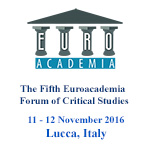Euroacademia Conferences
 Europe Inside-Out: Europe and Europeanness Exposed to Plural Observers (9th Edition) April 24 - 25, 2020
Europe Inside-Out: Europe and Europeanness Exposed to Plural Observers (9th Edition) April 24 - 25, 2020 Identities and Identifications: Politicized Uses of Collective Identities (9th Edition) June 12 - 13, 2020
Identities and Identifications: Politicized Uses of Collective Identities (9th Edition) June 12 - 13, 2020 8th Forum of Critical Studies: Asking Big Questions Again January 24 - 25, 2020
8th Forum of Critical Studies: Asking Big Questions Again January 24 - 25, 2020 Re-Inventing Eastern Europe (7th Edition) December 13 - 14, 2019
Re-Inventing Eastern Europe (7th Edition) December 13 - 14, 2019 The European Union and the Politicization of Europe (8th Edition) October 25 - 26, 2019
The European Union and the Politicization of Europe (8th Edition) October 25 - 26, 2019 Identities and Identifications: Politicized Uses of Collective Identities (8th Edition) June 28 - 29, 2019
Identities and Identifications: Politicized Uses of Collective Identities (8th Edition) June 28 - 29, 2019 The European Union and the Politicization of Europe (7th Edition) January 25 - 26, 2019
The European Union and the Politicization of Europe (7th Edition) January 25 - 26, 2019 7th Forum of Critical Studies: Asking Big Questions Again November 23 - 24, 2018
7th Forum of Critical Studies: Asking Big Questions Again November 23 - 24, 2018 Europe Inside-Out: Europe and Europeanness Exposed to Plural Observers (8th Edition) September 28 - 30, 2018
Europe Inside-Out: Europe and Europeanness Exposed to Plural Observers (8th Edition) September 28 - 30, 2018 Identities and Identifications: Politicized Uses of Collective Identities (7th Edition) June 14 - 15, 2018
Identities and Identifications: Politicized Uses of Collective Identities (7th Edition) June 14 - 15, 2018
The Politics Behind Unbuilt Memory: Memorial to the Six Million Jewish Martyrs, New York /“Topography of Terror” Documentation Center, Berlin
-
-

-
Presentation speakers
- Anna Bernardi, Institute for the History and Theory of Art and Architecture (ISA), Università della Svizzera Italiana - Accademia di Architettura, Mendrisio, Switzerland
- Download presentation
Abstract:
As is often the case, many studies on 20th-century collective memory in art and architecture generally tend to consider finished memorials. In some way, the story surrounding the finished memorial can be much more complete than an unbuilt memorial could ever have been, since finished memorials are often analyzed from the very beginning to the very end, when the public finally see them for the first time. However, paraphrasing the American scholar James E. Young, an unbuilt memorial often contains a more instructive – and perhaps even more interesting – story than a finished memorial.(1) Memorials marking an event of inhumanity such as the Holocaust are essentially complex artifacts. In many cases – depending on the memorial’s shape and location – its fulfilment implies a long history preceding its possible realization of public debates and practical attempts. These practical attempts work around the intention to mark the event involving not only remembering the victims (and mentioning the perpetrators), but also preserving the collective identity of a group or country. Practical attempts to preserve memory and collective identity will necessarily include various architectural projects, which have remained unrealized for several reasons. Among the most significant unbuilt architectural projects commemorating the victims and perpetrators of the Holocaust are the unrealized Memorial for the Six Million Jews Martyrs in New York City, designed by American architect Louis I. Kahn (1967-1973), and the planned “Topography of Terror” Documentation Center in Berlin, blueprinted by Swiss architect Peter Zumthor (1993-2004). This paper will examine the impact on the formation and preservation of collective identity in the United States and Germany exercised by the two above-mentioned unbuilt masterworks.
-
Related Presentations

The City as a Spectacular Monster and the Hysterical Baudrillardian Flâneur
- Gian Carla Agbisit

From Ms. Marvel to Ms. Shabash: Sex and Power Distribution in Bangladeshi and Western Cultures
- Tahseen Salman Choudhury
- Arzoo Ismail













